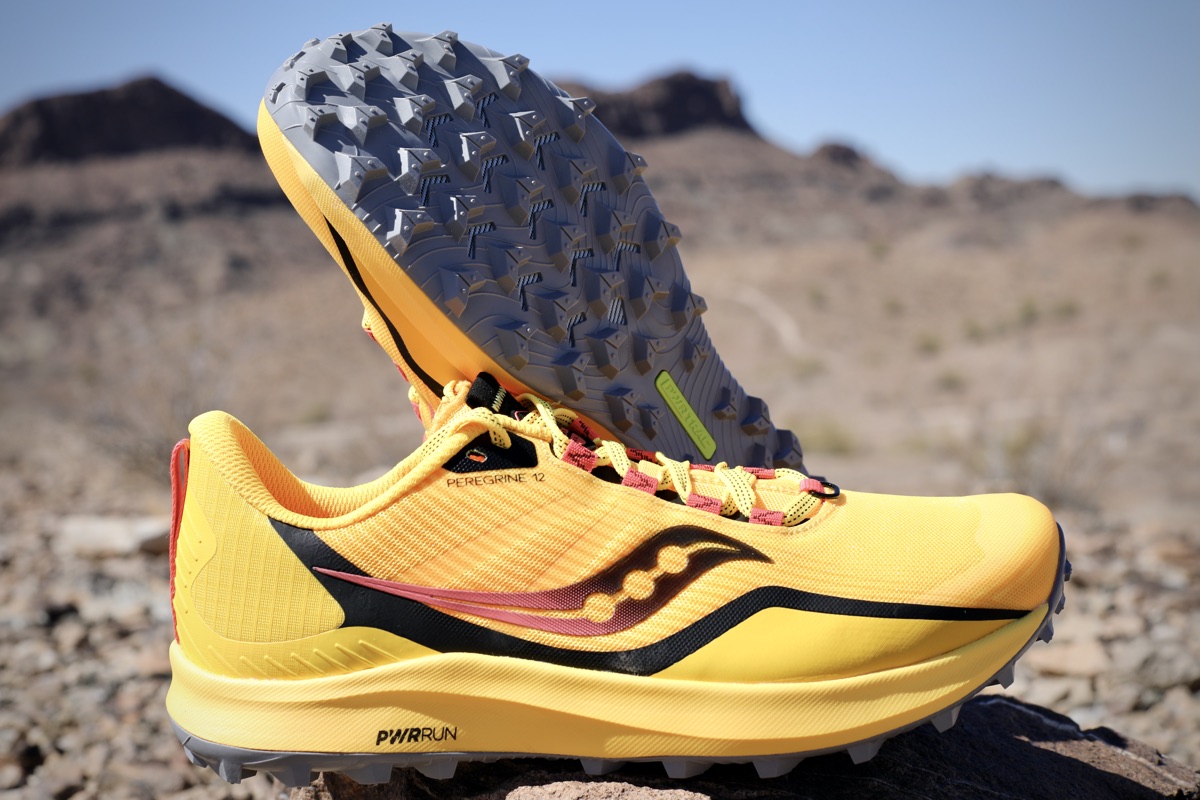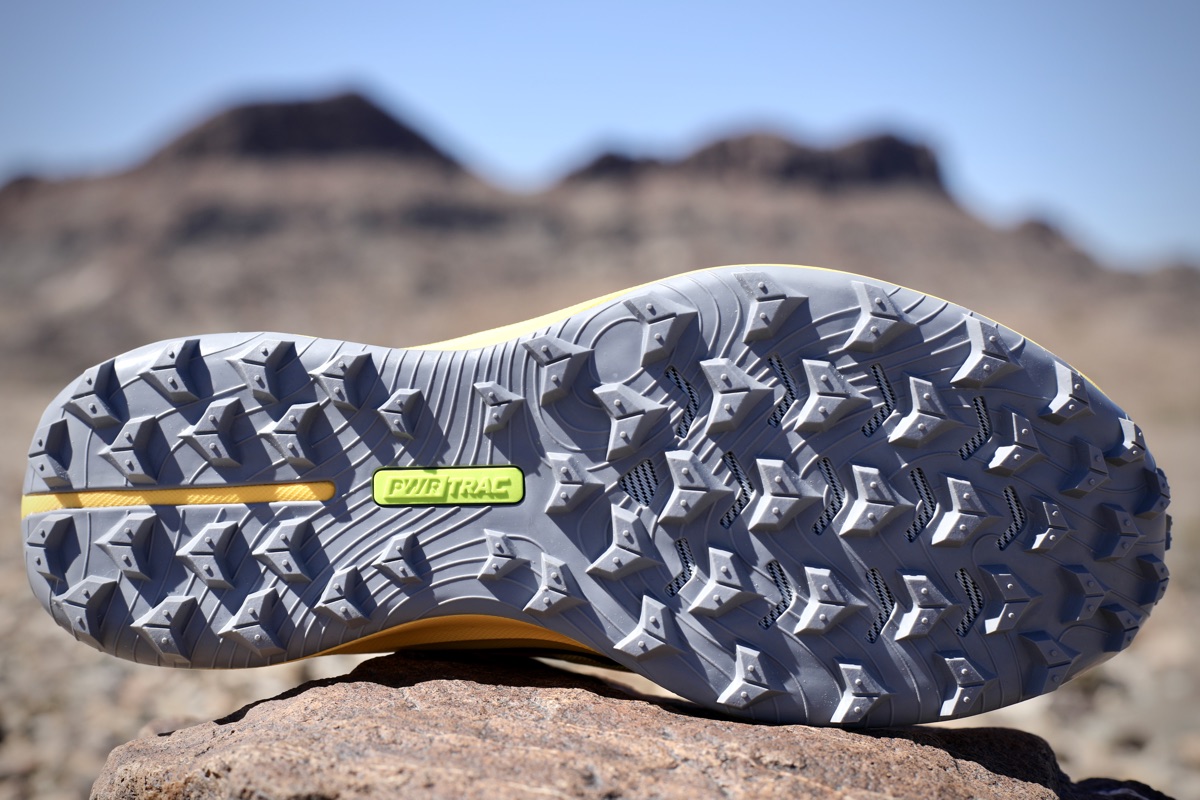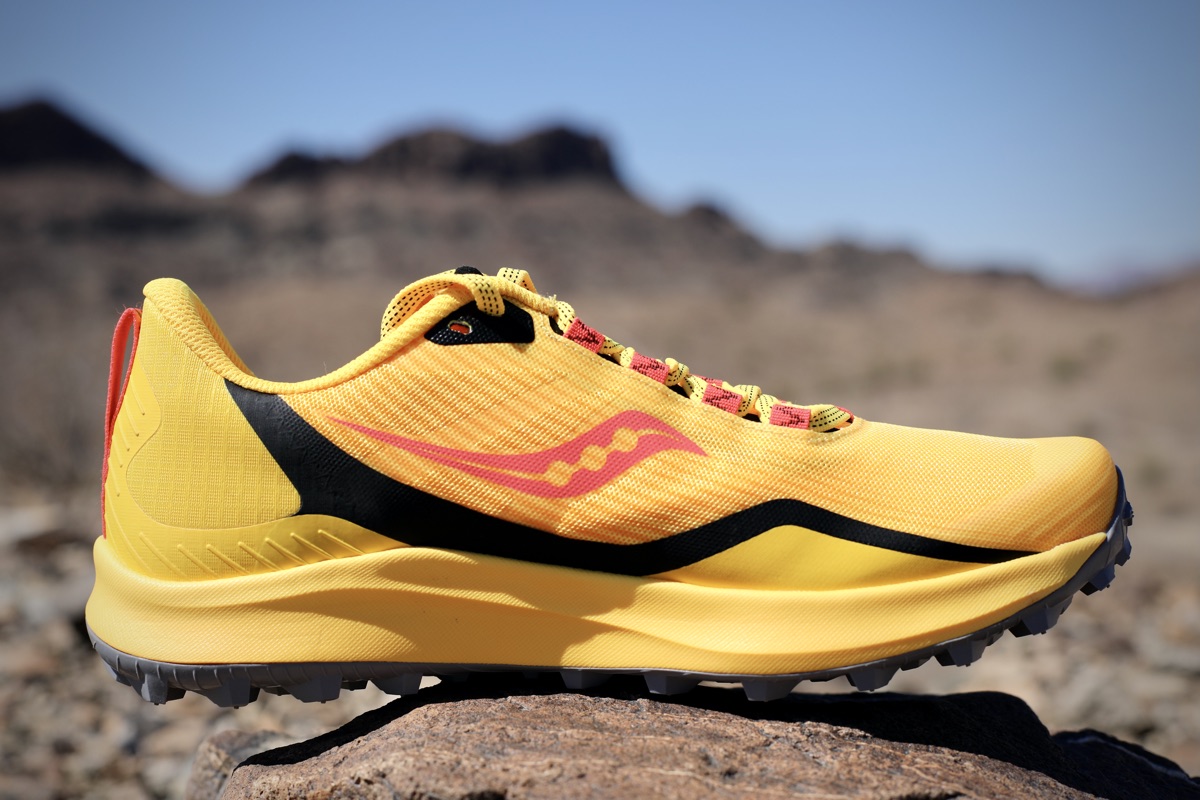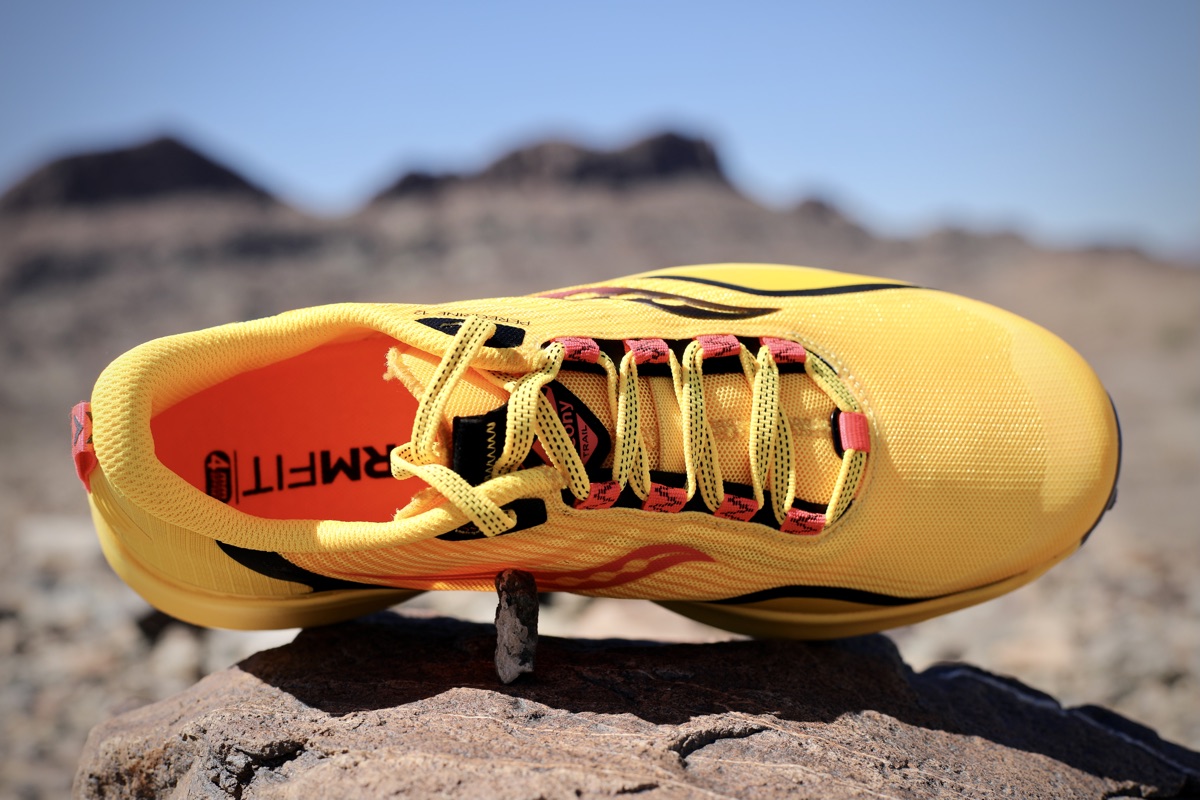For the latest on the Saucony Peregrine, check out our Saucony Peregrine 15 review.
Our Favorite Trail Running Shoes
Check out our Best Trail Running Shoes article to learn about our current favorite trail running shoes!
Saucony Peregrine 12 Review
Rejoice, the Saucony Peregrine 12 ($130) returns to its lightweight racing roots!
In this newest version of the Peregrine, the shoe drops weight, simplifies but improves the rugged outsole, uses an efficient midsole, and applies a pared-down upper to create a shoe that excels on fast training runs and races. Our only concern with this version is the durability of its upper, but if you use the shoe for what it’s intended, we think you’ll still get excellent mileage out of them. We dig deep into the Saucony Peregrine 12 in this video review.
The iRunFar team loves this shoe enough that we named it one of the top shoes in our best trail running shoes guide!
Shop the Men's Saucony Peregrine 12Shop the Women's Saucony Peregrine 12
Saucony Peregrine 12 Review Transcript
Hey, welcome to Trail Trials, the video review section of iRunFar. My name is Travis Liles and, in this video, we’re looking at the Saucony Peregrine 12.
This shoe has a 4-millimeter drop, with a stack height of 26.5 millimeters at the heel and 22.5 millimeters at the toe. It has an actual weight of 9.5 ounces (269 grams) in a men’s size 9.
It’s got a lot of good stuff going on. I’m excited about what they’ve done with this new edition of the shoe. With all that said, let’s see what this shoe is all about.
Saucony Peregrine 12 Outsole
To start off, if you were to compare the Saucony Peregrine 12 to the previous version of the Peregrine 11 — check out iRunFar’s Saucony Peregrine 11 review — version 12 is a much more stripped-down, simple outsole. This is a major win.
In fact, I feel like this shoe performs better across almost all terrain profiles than the previous version of the Peregrine did. They’ve done that by just not having so much going on.
It is a nice lug pattern. There are forward-facing lugs on the front, rear-facing lugs in the back, and the lugs are slightly deep. They bite well in dirt, mud, and that semi-wet type of environment. They really perform well on that.
This PWRTRAC outsole isn’t the greatest on really slick stuff, like marble-y type rocks or bridges that are made from wood that are wet and sort of get that slime on it. This isn’t the most friction-y outsole.
Because the outsole is simplified, there’s more space for the shoe to grip on. In that previous version, there was so much going on that it almost created a slicker bottom than what it should have been given how aggressive it looked. Overall, they’ve stripped down the outsole and because of that, the shoe weighs about two ounces less than the previous version.
There’s a rock plate in here. It’s a fabric-y, stitched-looking rock plate. It still allows for some flexibility, but it adds extra puncture resistance. That rock plate stops in the midfoot and transitions to just outsole and foam at the back. In fact, you can see a little bit of that foam pushing through.
Saucony Peregrine 12 Midsole
When you look at the midsole on the Saucony Peregrine 12, it uses Saucony’s PWRRUN. This is more of a general-purpose midsole foam, more of a classic type of foam. It’s a little bit firmer. For this shoe’s purpose, which going back to the original Peregrine that is fast across lots of different terrains, this is the right type of foam to use.
It doesn’t deform. It doesn’t mush out the sides. It holds its own. That helps propel this shoe forward without having any tricks up its sleeve.
There’s no carbon plating. It’s not a rocker outsole. It has a little bit of this toe-off design. It’s really a shoe that’s meant for moving quickly. This single-density PWRRUN foam is the right choice to add a little bit of that spring in your step without having to have a whole bunch of extra stuff going on.
Saucony Peregrine 12 Upper
Moving to the upper of the Saucony Peregrine 12, it is again simplified. You can see it’s a very simple kind of mesh patterning. Here it is all the way around the shoe. There are way less overlays compared to previous versions of the Peregrine.
The only place where you’re going to see some of these overlays are on the upper part of the shoe. That’s done along the lacing area to create some structure so that when you pull the laces together, it creates this cage, this wrap, from the heel all the way down to the toes. It’s just enough on this upper to make this feeling of a lockdown fit that you can run fast in, without creating so much overlay that the shoe’s inflexible, that it’s heavy.
Another thing I’ll comment on is the width of the toebox. For a Peregrine, there’s a fair amount of room for your toes to wiggle. And you can see it’s a little blunter-looking. There’s some room for your toes to move and really nothing getting in the way. No material, no weird things. Just mesh that lets your toes do what they need to do.
From a protection standpoint, there’s a decent amount here. This is hard, from the outsole wrapping around to the front. Then there’s this extra overlay. There are a couple of layers. There’s even a little bit extra on the sides when you might be catching or scuffing something.
From a heel standpoint, it is a good compromise of a heel counter where it is soft up top, so you don’t have any pushing against your Achilles tendon. It’s soft and malleable. Once it gets about halfway down, there is a structured heel counter. That works well with this lacing system with overlays that are on here. Having that little bit of heel counter in there really locks my foot in well, for a narrow-ish type of heel, while giving my foot the ability to move around without feeling impeded by a hard counter on the back.
From a tongue standpoint, it’s a thin piece of foam sandwiched between some mesh. It is gusseted inside and that starts right around the uppermost fabric eyelet and works its way all the way down into the inside of the shoe, hopefully avoiding those hotspots.
There are two extra details that I want to call out. One is the sock liner. The sock liner uses a different type of midsole foam. Versus being this PWRRUN or just standard EVA foam, they use their PWRRUN+ foam in the sock liner. This is a thicker sock liner than you’re used to seeing in most of the shoes, and I really like it.
One, this is what’s used in a lot of their road shoes, this PWRRUN+. It’s a rebound-y, cushiony type of foam. Without doing an entire midsole in it, they use this, so it adds a little extra cushion. It adds a little extra bounce.
From a durability standpoint, I’m really impressed with this sock liner, which isn’t something that I say very often, but there’s not very much pitting. If I was to pull a sock liner off one of my other shoes, there would be very thin spots where my big toe puts pressure and probably across some other toes as well.
This sock liner doesn’t seem to have any of that. This is a nice compromise of putting a springier, more advanced foam type in the shoe while not creating something that is wobbly or feels out of control when you’re descending super-fast. I like this kind of foam that they’re using for the sock liner and hope to see more of this type of thing, advanced foam and sock liners versus sock liners being an afterthought.
The last thing I want to show is a cautionary tale. I’m getting some early wear. This shoe has about 150 hard miles on it. But right here at my flex spot, I’m getting some fraying that’s coming from this overlay. I just wanted to point out this worrisome spot.
Saucony Peregrine 12 Overall Impressions
In closing, I’m really pumped about what’s going on with the Saucony Peregrine 12. This Peregrine is as close to the original heritage of the Peregrine as we’ve seen in a whole bunch of versions.
In fact, in my review of the Saucony Peregrine 11, I made a statement where I said this is a trail running shoe. I meant that it was a general trail shoe. It didn’t really have a category that it fit into.
The Peregrine 12 moves back toward a trail racing shoe. It still has that low profile. It’s got the PWRRUN+ sock liner that adds a little bounce and spring to it while also doing some work to diffuse the poking and pressure of the ground. There’s a rock plate in there that’s not too heavy. The tread is aggressive and works in most scenarios except for the slickest type of stuff.
They just get a lot of things right that move back to what this shoe originally was. If you were an original Peregrine lover and fell out of favor with them over the last handful of versions, then this could be the one to draw you back in.
The negatives; one, it stained super easy. It’s looked like this since my second run. This shoe was a nice, bright yellow. It immediately got this weird sort of green, dirty look, and I couldn’t ever get that out.
Then the other negative is this fraying that’s happening in the one spot on the upper. The tongue is gusseted so it sits over that wear area and more than likely would keep stuff from falling into it.
But when you start stripping down a shoe, something’s got to give, and in this case, we’re getting a little bit of fraying. This shoe won’t make it 500 miles. For me, probably 300 miles is about as good as I’m going to get.
If you’re okay with that, and again, if you look at this as a specialty racing shoe, then that might be just fine. You look at it as, it’s not my everyday trainer. I’m going to wear this when I want to go fast. If that’s what you are looking for in a shoe, then the Peregrine 12 meets all the conditions that this shoe is meant to do.
Shop the Men's Saucony Peregrine 12Shop the Women's Saucony Peregrine 12
Call for Comments
With that, questions, comments? What’s your love of the old Peregrines? Have you tried the new ones? Do you think they match up to that? Or are you upset that they’ve moved away from more of a traditional do-everything shoe and they’re starting to slide back into a faster-paced, racing lightweight shoe? Leave those comments below. Thanks for watching. We’ll catch you next time.
[Editor’s Note: If you’re affiliated (i.e., an employee, ambassador, etc.) with a shoe brand, please share your relation in each of your comments on this article. Thanks!]





